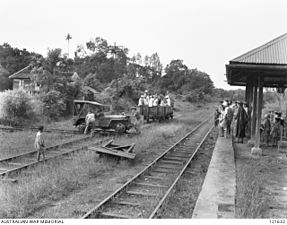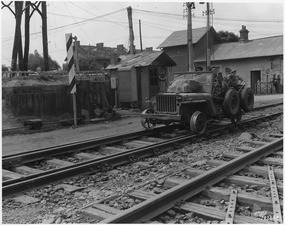Jeep engine


A jeep engine is a locomotive or trolley that has been converted from a jeep . Jeep engines were developed during the Second World War because the roads in war zones were impassable in many places and there were often too few locomotives.
history
America
Written mentions of the play on words "Jeepomotive" can be found in a report about US Army Major Earl Wiley, who had made jeep conversions suitable for rails . Trains pulled by jeeps on rails were also used in Burma around 1944 .
Australia

In 1945, Australian soldiers in Borneo made several jeeps suitable for use by making modifications to make up for the war-related lack of locomotives for the narrow-gauge railways there. The conversion was quite simple, depending on the track width: the wheels were exchanged for steel wheels with flange , which are common on the railway , a suitable coupling was attached at the rear and the steering wheel was blocked. The axles had to be modified for narrow-gauge tracks.
Great Britain
During the Second World War, the British used adapted jeeps for rail transport in France and Burma, among others .
Loads and speeds
A jeep that was kg approved by its manufacturers in road operation for trailer loads of 500, was on track due to the lower rolling friction of rolling stock draw much higher loads much. During the Australian military action on Borneo, a jeep engine was used to pull a railroad car with an empty weight of three tons and a load of four tons of sand. The average speed for train operations was set at 24 km / h, which apparently could be maintained despite delays on the line. In the Philippines , a jeep is said to have pulled a train with a total weight of 52 tons over a distance of 30 km at an average speed of 35 km / h.
Military operation
General Wootten crosses the Bongowan
Kinarut train station with turntable
British jeeps south of Mandalay , Burma, 1945
Web links
Individual evidence
- ↑ Truck 1/4 ton 4x4 GS, jeep: Australian Army Military History Section.
- ↑ Jeeptrain. The Mercury, Hobart, Tasmania, Monday September 3, 1945.
- ↑ Nevington War Museum: USA - Jeep Variants - Railway jeeps.
- ↑ Herald-Journal, January 20, 1945.
- ^ The University of Dayton Alumnus, January 1945.
- ↑ Boyd Sinclair: Running On Time In a Timeless Land: An elephant can be a locomotive and a tiger sometimes stopped a train. Ex-CBI Roundup, November 1950 Issue.
- ↑ Testing in Australia.
- ↑ a b c Australian War Memorial, Reference No OG3138.
- ↑ a b Military Jeep History.









